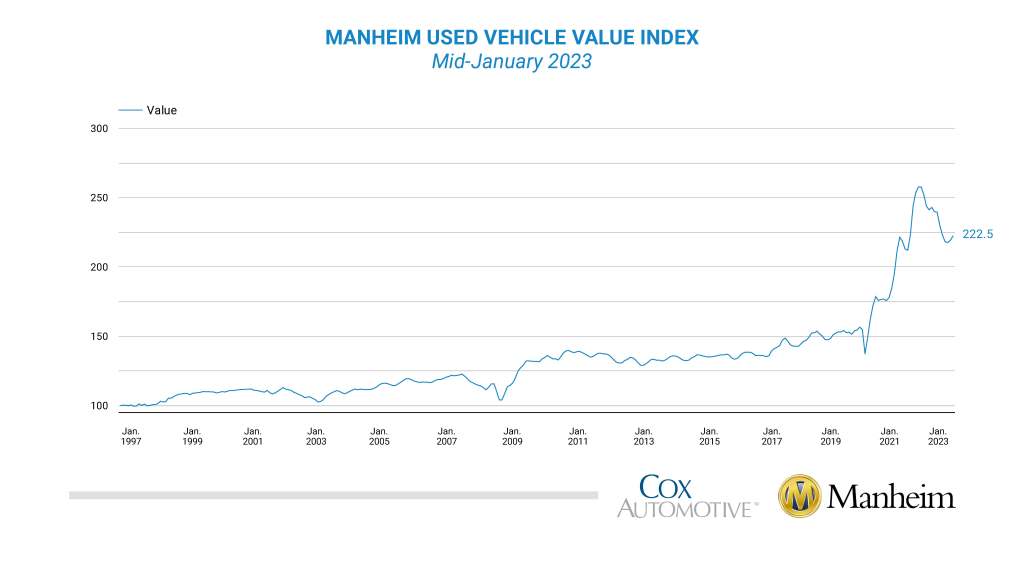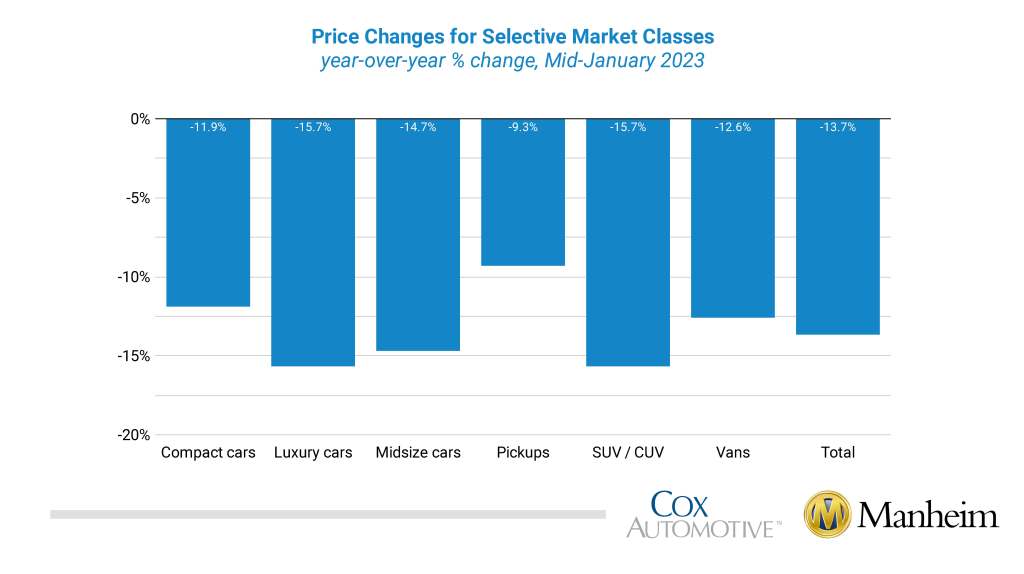Data Point
Wholesale Used-Vehicle Prices See Another Increase in First Half of January
Wednesday January 18, 2023
Article Highlights
- Wholesale used-vehicle prices increased 1.5% from December in the first 15 days of January.
- The mid-month Manheim Used Vehicle Value Index rose to 222.5, which was down 13.7% from the full month of January 2022.
- The seasonal adjustment drove most of the gains.
Wholesale used-vehicle prices (on a mix-, mileage-, and seasonally adjusted basis) increased 1.5% from December in the first 15 days of January. The mid-month Manheim Used Vehicle Value Index rose to 222.5, which was down 13.7% from the full month of January 2022. The seasonal adjustment drove most of the gains. The non-adjusted price change in the first half of January was an increase of 0.3% compared to December, while the unadjusted average price was down 12.1% year over year.
Over the last two weeks, Manheim Market Report (MMR) prices have moved in opposite directions but left prices about where they would typically be in mid-January. The first week saw a higher-than-normal decline of 0.4% in the Three-Year-Old MMR Index, but that was followed by an increase of 0.3%, leaving prices down 0.1%, which was the average cumulative change in the six years from 2014 through 2019. Over the first 15 days of January, MMR Retention, the average difference in price relative to current MMR, averaged 99.7%, indicating that valuation models are just below market prices. The average daily sales conversion rate of 57.2% in the first half of January increased relative to December’s daily average of 50.2% and was close to the January 2019 daily average of 57.7%.
The trend that started in October continued into 2023, with all eight major market segments seeing seasonally adjusted prices that were lower year over year in the first half of January. Pickups had the smallest decline at -9.3%, while compact cars and vans lost less compared to the overall industry (down 13.7%) in seasonally adjusted year-over-year changes. Four of eight major segments saw price increases compared to December, with gains from 0.7% to 2.8%. The remaining segments saw declines of between 0.2% and 1.4%.
Retail and Wholesale Days’ Supply Below Normal in Mid-January
Using estimates based on vAuto data as of Jan. 16, used retail days’ supply was 48 days, which was down seven days from the end of December. Days’ supply was down 12 days year over year and down seven days compared with the same week in 2019. Leveraging Manheim sales and inventory data, we estimate that wholesale supply ended December at 32 days, up three days from the end of November and up five days year over year. As of Jan. 15, wholesale supply was at 32 days, unchanged from the end of December, unchanged year over year, but nine days lower than 2019. Used supply measured in days’ supply and compared to 2019 suggests supply is below normal for this time of year, which indicates that downward price pressure should be lower than normal.
Rental Risk Prices and Mileage Down in First Two Weeks of January
The average price for rental risk units sold at auction in the first 15 days of January was down 9.7% year over year. Rental risk prices were flat compared to the full month of December. Average mileage for rental risk units in the first half of December (at 56,000 miles) was down 5.3% compared to a year ago but up 6.0% month over month.
Consumer Sentiment Measures Up to Start January
The initial January reading on Consumer Sentiment from the University of Michigan jumped 8% to 64.6 as views of both current conditions and future expectations increased. Median expected inflation rates declined one year out and increased slightly over the next five years. Consumers’ views of buying conditions for vehicles improved and were at their best level since August 2021. The improvement in the Michigan index is more substantial than the modest improvement in January so far in the daily index of consumer sentiment from Morning Consult. That index was up only 0.1% for the month through Jan. 15. Sentiment improved at year-end with gas prices declining, but gas prices have increased slightly to start 2023. According to AAA, the average price for unleaded gasoline rose by 3% in the month so far as of Jan. 15, but the average price per gallon at $3.31 was unchanged year over year.
A replay is available for the Q4 2022 Manheim Used Vehicle Value Index Call held on Monday, Jan. 9. Listen now.
The complete suite of monthly MUVVI data for January will be released on Feb. 7, 2023, the fifth business day of the month, as regularly scheduled. The next quarterly call on Friday, April 7, 2023, at 11 a.m. EDT.
If you have any questions regarding the Index or would like to sign up for updates, please contact the Cox Automotive Industry Insights team at Manheim.Data@coxautoinc.com.
Note: The Manheim Used Vehicle Value Index was adjusted to improve accuracy and consistency across the data set as of the January 2023 data release. The starting point for the MUVVI was adjusted from January 1995 to January 1997. The index was then recalculated with January 1997 = 100, whereas prior reports had 1995 as the baseline of 100. All monthly and yearly percent changes since January 2015 are identical. Learn more about the decision to rebase the index.


